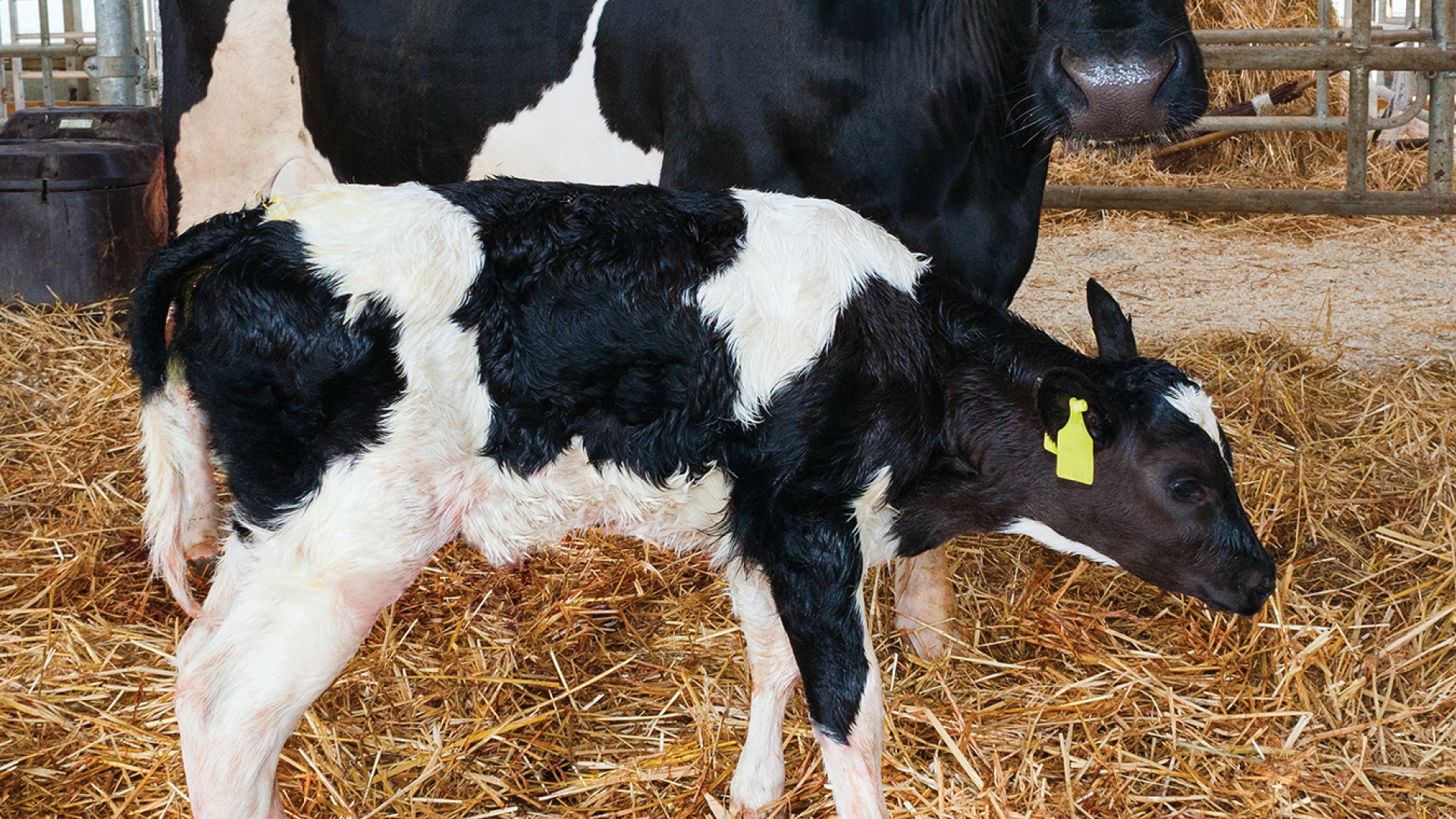Optimizing immune function in neonatal calves
By Dr. Brian Miller
Contrary to popular belief, vaccinating a calf against a particular disease doesn’t mean that animal is immediately protected. Many factors influence a) whether an animal can respond to a vaccine and b) the level of protection afforded by vaccination.
Vaccination is the act of administering a vaccine, and immunization is an appropriate immune response following vaccine administration that provides protection from disease. While vaccination is essential for disease control and prevention, even the “best” vaccines can’t overcome deficiencies in colostrum management, environment or nutrition.

Newborn calf immunology challenges
Unlike most mammals, the bovine species has a unique placenta that prevents in-utero transfer of protective antibodies. As a result, newborn calves are extremely vulnerable to diseases once they leave the protective environment of their dam’s womb.
Sudden exposure to an environment that contains numerous bacteria, viruses and parasites can easily overwhelm the calf’s immune system, which is functional but less responsive and less protective than the immune system of an adult cow.1 The health (and sometimes the life) of the animal is dependent on successful defense against these potential microbial invaders.
Resistance to invasion is maintained by multiple, interlinked defense mechanisms that collectively we call the immune system of the calf. Our role as industry professionals is to manage and optimize immune function of the calves under our care. The care that calves receive prior to delivery and in the early weeks of life can have a dramatic impact on their future performance, productivity, and profitability.
To improve calf health, Dr. Sheila McGuirk, University of Wisconsin School of Veterinary Medicine professor emeritus, advocates a basic care package that consists of “5 Cs:”
- Colostrum
- Calories
- Consistency
- Comfort
- Cleanliness
McGuirk says these 5 Cs can be simply divided into colostrum, nutrition and environment. These three pillars, like the legs of a milking stool, are the foundations of calf health.
Attention to how vaccines are handled and administered will also influence how many vaccinates truly become immunized. Implement the following management practices to optimize immune responses in newborn calves to increase the percentage of animals that respond to vaccination:
Practices before calving
A healthy calf begins with a healthy cow, which means care and management begins several weeks before the calf is born. Never underestimate the importance of the prepartum environment and key management practices on calf health.
Underweight calves experience more health issues, and approximately two-thirds of the fetal growth occurs in the last trimester. Therefore, it is critical to maintain body condition score (BCS) in prepartum dams to avoid negative energy balance and prevent both cow and calf health from suffering. Maintain BCS and fetal growth by ensuring fresh water is readily available and providing adult cows adequate bunk space to maximize dry matter intake (G. Oetzel DVM, personal communication, May 2022).
It is commonplace to immunize late-gestation dry cows and replacement heifers with a variety of vaccines. Utilize a scours vaccine such as BOVILIS® GUARDIAN® to increase concentrations of antigen-specific antibodies in the colostrum. The vaccine, coupled with excellent colostrum management as well as feeding transition milk, helps reduce diarrhea risk in newborn calves. Consult your veterinarian regarding usage and the importance of proper vaccine timing to maximize vaccine efficacy.
Practices at calving
Focus on the cleanliness of the environment the calf is born into — the maternity pen should be an area for birthing only. Restrict entry of disease carrier dams or people that have just worked with sick cattle or calves.
Calves that are born into bedding highly contaminated with fecal material will have immediate exposure to numerous pathogens from direct contact or aerosolization. Reduce pathogen exposure by removing the calf before standing attempts, and use sanitized transport equipment to move the animal to a clean holding area for processing (colostrum administration, warming, navel dipping, tagging and application of calf coats when required).
Poor colostrum management continues to be a major contributor to excessive calf losses resulting from scours and pneumonia. Because calves are born devoid of protective antibodies, colostrum management is the single most important management factor in determining calf health and survival.2 Colostrum fills an essential need for the young calf for both disease protection and immune development (C. Chase DVM, personal communication, May 2022).
Dr. Sandra Godden, professor of veterinary population medicine at the University of Minnesota, recommends the “5 Qs of colostrum management”5 to help calf growers raise healthier and more productive calves (S. Godden, DVM, personal communication, May 2022):
- Quality: IgG concentration should be >/=50 g IgG/L.
- Quantity: First feeding should be 10% to 12% of birth weight; second feeding (12 hours later) should be 5% of birth weight.
- Quickness: Feed all calves within one to two hours after birth.
- sQueaky clean: Reduce bacterial contamination through sanitary collection procedures, the use of clean storage and feeding equipment, and by proper cooling.
- Quantify: Evaluate serum total proteins (STP) at one to 10 days of age to evaluate a colostrum management program.
Practices after calving
After processing calves and ensuring they’ve had enough high-quality colostrum, focus on the remainder of McGuirk’s 5 Cs.
Calories: The goal is to ensure >/= 1 lb average daily gain (ADG) in the first week of life.3 The goal is to double birth weight by 56 days of age.4 Maintaining adequate hydration is essential to improve ADG and optimize calf immunity. Clear nasal and ocular discharge are good indicators of proper hydration.
Consistency: Consistent feeding practices are keys to calf health since calves are creatures of habit. Be consistent regarding timing, temperature, and percent solids to help prevent gastrointestinal issues. Provide water within 20 to 30 minutes after the milk meal. Significant variation in these practices may lead to digestive problems or even death.
Comfort and cleanliness: Ensure that the calf environment is clean, dry, well bedded and properly ventilated.
Intranasal vaccines
While maternal antibodies from colostrum may impede some injectable vaccines from inducing an immune response in newborn calves,5 that’s not the case for intranasal vaccines. For many veterinarians, intranasal vaccines have become the preferred route to immunize pre-weaned dairy calves to help reduce respiratory disease risk. The nostrils are a natural portal of entry for common respiratory viruses (IBR, BRSV, PI3) and bacteria (Pasteurella multocida, Mannheimia haemolytica).
Intranasal vaccines like BOVILIS® NASALGEN® 3 and BOVILIS® NASALGEN® 3-PMH induce a rapid anti-viral response followed by the generation of disease-fighting antibodies (including mucosal IgA and systemic IgG) within the first two weeks of life.5 When a follow-up injectable vaccine is administered to the animal later in life that contains the same antigens, an anamnestic or memory response results due to a prior generation of IgG.5 This enhances respiratory disease protection.
Other benefits that intranasal vaccines offer include:
- Less stress on the calf
- Needle-free, which is the ultimate in BQA compliance
- Less likely to induce systemic inflammation, compared to injectable vaccines
- Reduces the effects of bacterial endotoxins contained in injectable vaccines (Pasteurella multocida, Mannheimia haemolytica)
- A rapid anti-viral response followed by the generation of disease-fighting antibodies (including mucosal IgA and systemic IgG) within the first two weeks of life
It is beneficial that intranasal vaccines like BOVILIS® NASALGEN® 3 and BOVILIS® NASALGEN® 3-PMH can generate systemic IgG antibodies. When a follow-up injectable vaccine is administered to the animal later in life that contains the same antigens, an anamnestic or memory response results due to a prior generation of IgG. This potentiates respiratory disease protection.
Learn more about the newest options in intranasal respiratory vaccines at Nasalgen.com, or contact your Merck Animal Health representative.
References
- Dr. Sheila McGuirk, Managing the young calf – Keep it simple!
- Godden et. al., Colostrum management for dairy calves, Vet. Clin. Food. Anim. 35.2019;535-556.
- Dr. Terri Ollivett, Department of Medical Sciences, University of Wisconsin-Madison School of Veterinary Medicine, presentation at the DCHA Annual Meeting, Minneapolis, Minnesota, 2022.
- Van Amburgh, Mike. What have we learned about calf nutrition and management over the last 10 years: A lot! American Association of Bovine Practitioner, 2009.
- Merck Animal Health Study MS-N3PMH-3-19: Efficacy of vaccination in colostrum fed 7-day old calves when using multivalent intranasal vaccine in the face of maternal antibody.
Find more content for your dairy operation.
About the author

Dr. Brian Miller, D.V.M.
Dairy Technical Services, Merck Animal Health
